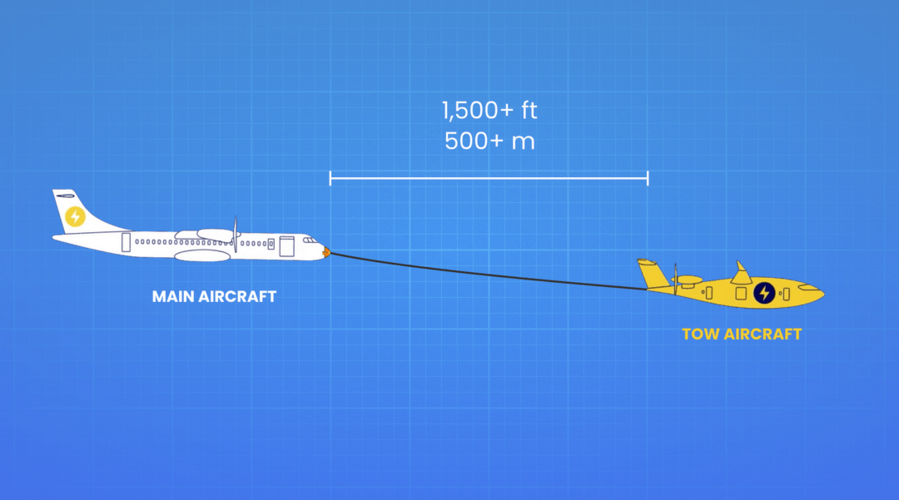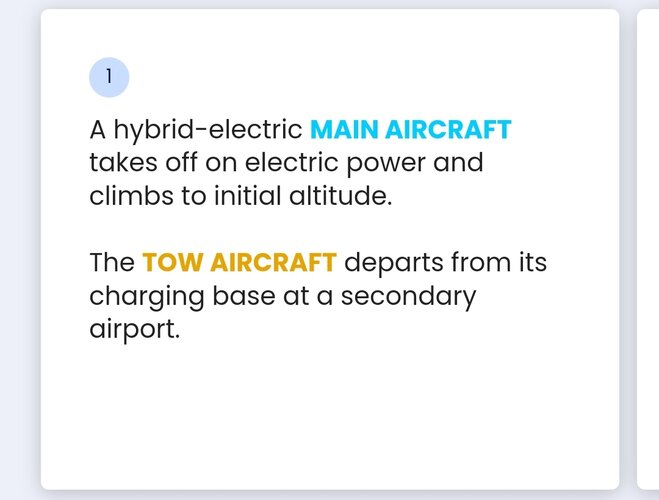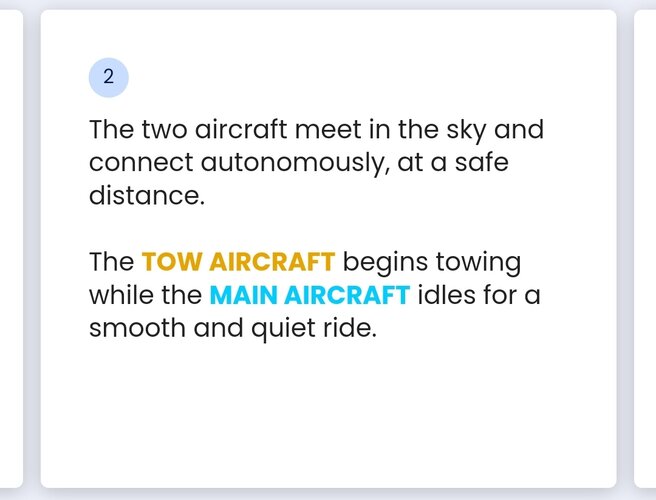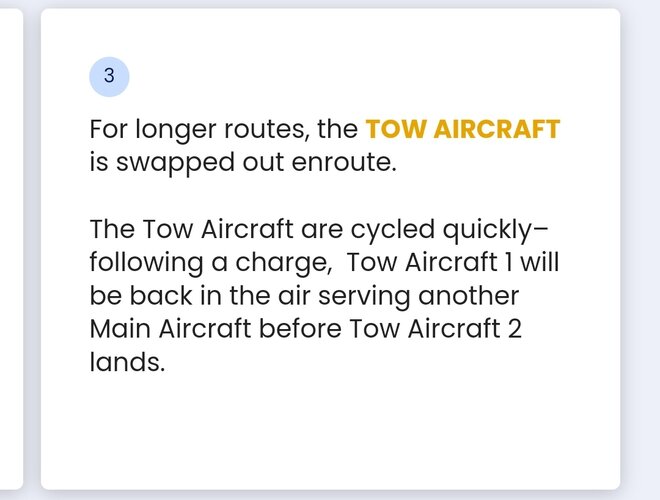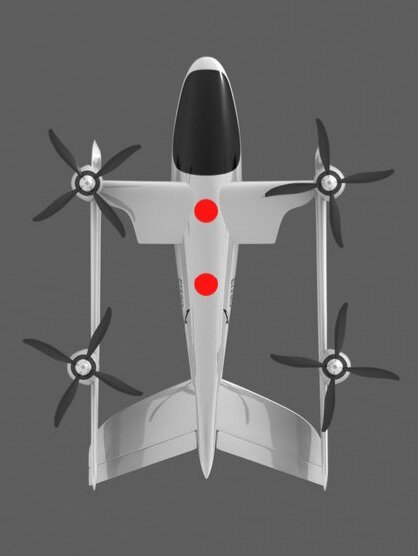You are using an out of date browser. It may not display this or other websites correctly.
You should upgrade or use an alternative browser.
You should upgrade or use an alternative browser.
VTOL On Demand Mobility
- Thread starter Grey Havoc
- Start date
Yes. That's crazy. They can even yaw with the drag, I see. Just like a flying wing.
See also that they haven't done anything for tempering gusts with the inherent active flap config they have, despite the amplitude of vertical movement they get (rigid wing) .
I admire the hard (but fairly narrowly limited) work, however, this thing is a vomit comet that no one should whish, until the design evolves, to be stuck in with half a dozen of passengers inevitably getting sick due to the almost unstoppable pendular oscillations around the yaw and vertical axis.
See how this flight was even recorded in calm air (at ground level).
See also that they haven't done anything for tempering gusts with the inherent active flap config they have, despite the amplitude of vertical movement they get (rigid wing) .
I admire the hard (but fairly narrowly limited) work, however, this thing is a vomit comet that no one should whish, until the design evolves, to be stuck in with half a dozen of passengers inevitably getting sick due to the almost unstoppable pendular oscillations around the yaw and vertical axis.
See how this flight was even recorded in calm air (at ground level).
Last edited:
- Joined
- 24 November 2008
- Messages
- 1,549
- Reaction score
- 2,611
Yeah, vomit comet  ... Imagine how hard those servo actuators have to work to keep the desired trajectory.
... Imagine how hard those servo actuators have to work to keep the desired trajectory.
At 1:36 starts a longer period were the flow seems to be laminar, so in fast level flight, the flow stays attached.
They are still using black painted windows, which indicates, that the prototype is still a more or less empty shell (exept the batteries inside). I guess, they needed to provide some good news after the share value has fallen down to just 0.64 €....
They are still using black painted windows, which indicates, that the prototype is still a more or less empty shell (exept the batteries inside). I guess, they needed to provide some good news after the share value has fallen down to just 0.64 €....
- Joined
- 24 November 2008
- Messages
- 1,549
- Reaction score
- 2,611
Btw, 136 kts is rather the cruise speed of a modern helicopter than a jet  ...also, is "targeted maximum speed" equivalent to cruise speed?
...also, is "targeted maximum speed" equivalent to cruise speed?
If you go back to the first page of this thread, you will see, that they once promised 400 km/h and are now down to 250 km/h (136 knts). I guess, this should be the cruise speed and maximum speed as well, but who knows…
I don’t understand that jet approach either, they probably did it, because they considered propellers to be antiquated…
I don’t understand that jet approach either, they probably did it, because they considered propellers to be antiquated…
- Joined
- 24 November 2008
- Messages
- 1,549
- Reaction score
- 2,611
Volocopter establishes production setup for electric air taxis
https://verticalmag.com/press-relea...-production-setup-for-electric-air-taxis/?amp
Edit: Tech specs published at their homepage as of today (2019, approximations not yet tested in flight).

https://verticalmag.com/press-relea...-production-setup-for-electric-air-taxis/?amp
Edit: Tech specs published at their homepage as of today (2019, approximations not yet tested in flight).
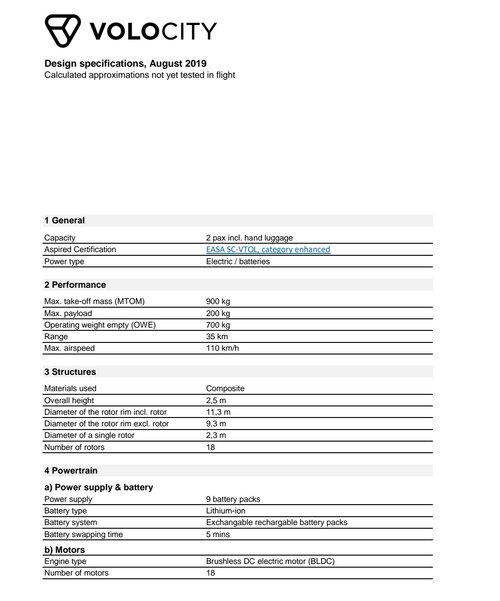
Last edited:
alberchico
I really should change my personal text
- Joined
- 14 January 2014
- Messages
- 706
- Reaction score
- 1,512

The ballpark price for certifying an eVTOL is going up
Good luck bringing your air taxi to market for less than $1 billion.
 theaircurrent.com
theaircurrent.com
It has a paywall but gives you an idea of the massive sums required to get a design certified. How many of these startups have more than a billion dollars in capital to certify their design and build it in the large numbers that their business plans call for ? Not to mention building the production facilities from scratch as well as setting up all the infrastructure needed to support these aircraft in the field once they're delivered to customers.
It is hard to say how much Lilium money was really spend for certification. Lilium presented many, partially very different, designs and built at least two different prototypes for testing. All the design work going in circles didnt really help.
If I’m right, they also bought shares from two different battery companies and surely spend a lot of money for that.
They simply had a lot of money to spend and used a lot of it to make a design work, which has limited potential. Blaming the certification process is one way to explain where all the money had gone..
If I’m right, they also bought shares from two different battery companies and surely spend a lot of money for that.
They simply had a lot of money to spend and used a lot of it to make a design work, which has limited potential. Blaming the certification process is one way to explain where all the money had gone..
@VTOLicious Volocopter really did a lot of flight testing and even manned flights. I'm quite confidend, they will really make a product out of the Volocity.
alberchico
I really should change my personal text
- Joined
- 14 January 2014
- Messages
- 706
- Reaction score
- 1,512

Joby Aviation lands $55 million contract from US Air Force
Electric aircraft maker Joby Aviation will deliver up to nine air taxis to the U.S. Air Force under a $55 million contract extension that marks the company’s first revenue-generating operations, the company announced on Tuesday.
Some good news for this project. If the USAF likes how these aircraft perform in real world conditions this could lead to an even bigger order down the line.
- Joined
- 18 October 2006
- Messages
- 4,209
- Reaction score
- 4,904
Government subsidy. In fairness it is not an exclusively French method. The USAAF financed a significant level of effort prior to WW2. Soviet and Russian. I am sure that there are any number of historical precedence.@yasotay French???
- Joined
- 18 October 2006
- Messages
- 4,209
- Reaction score
- 4,904
A poor choice of words for an international community. Of course, there is no French connection. The intent of the message was that the USAF is subsidizing Joby's efforts to get qualifications in a similar manner as the French government supports Airbus helicopter development and certification.But what exactly is French about Joby or the US Airforce? Joby it an American company!
In fact, I didn’t know that “French” is synonymous for relying on government (European commission) support, despite I pay for it every month (to be fair, not only the French but southern and eastern Europe as whole…).
Big bad Airbus (Eurocopter).The intent of the message was that the USAF is subsidizing Joby's efforts to get qualifications in a similar manner as the French government supports Airbus helicopter development and certification.
Of course no blame should go to any of the US helicopter manufacturers (Bell, Boeing, Sikorsky, MD) who have been gorging themselves feeding on the trough with US DoD dollars for decades… so much so that they mostly forgot what it’s like to compete in the civilian market!
- Joined
- 18 October 2006
- Messages
- 4,209
- Reaction score
- 4,904
Bell has a very healthy civil market share. Until recently Sikorsky did as well. MD is coming out of bankruptcy. Boeing ...well you got me there.Big bad Airbus (Eurocopter).The intent of the message was that the USAF is subsidizing Joby's efforts to get qualifications in a similar manner as the French government supports Airbus helicopter development and certification.
Of course no blame should go to any of the US helicopter manufacturers (Bell, Boeing, Sikorsky, MD) who have been gorging themselves feeding on the trough with US DoD dollars for decades… so much so that they mostly forgot what it’s like to compete in the civilian market!
I suppose it is a matter of perspective. My apologies if I have caused discord.
I don't know where it stands exactly in the search for on Demand mobility, but I guess that having something like that when weather and traffic are not cooperating, like in the real world, would make sense.
View: https://youtu.be/cQNCSbyyAkc
Let's see what the thread owner think about it ( @Grey Havoc long time we haven't read from you)
Let's see what the thread owner think about it ( @Grey Havoc long time we haven't read from you)
- Joined
- 24 November 2008
- Messages
- 1,549
- Reaction score
- 2,611
I don't know where it stands exactly in the search for on Demand mobility, but I guess that having something like that when weather and traffic are not cooperating, like in the real world, would make sense.
View: https://youtu.be/cQNCSbyyAkc
Let's see what the thread owner think about it ( @Grey Havoc long time we haven't read from you)
So, what is your suggestion how this system could be used in the context of urban air mobility?
You might get delayed, re-routed for weather, fly a longer leg than what a single recharge can provide or have to do circuits for traffic at the end of your flight. This thing might hook you for safety and, potentially, provide recharge. It would operate like a tow airplane: stanby on an airfield and launch on request.
Being overpowered for providing tow, it could do fast recharge but also could takeoff short (no need to lineup behind all aircraft at airfield threshold), climb fast, cruise high.
Being overpowered for providing tow, it could do fast recharge but also could takeoff short (no need to lineup behind all aircraft at airfield threshold), climb fast, cruise high.
Last edited:
shedofdread
ACCESS: Top Secret
- Joined
- 14 November 2009
- Messages
- 593
- Reaction score
- 400
It's one of those things that's fascinating but not quite sure [yet?] what use it actually is. Rescuing sailplanes in a Thunderbirds-esque style??? ("We've got Ventus stuck in an alpine valley WITH NO HOPE OF RESCUE!", "5, 4, 3, 2, 1" etc etc)I don't know where it stands exactly in the search for on Demand mobility, but I guess that having something like that when weather and traffic are not cooperating, like in the real world, would make sense.
View: https://youtu.be/cQNCSbyyAkc
Let's see what the thread owner think about it ( @Grey Havoc long time we haven't read from you)
- Joined
- 27 May 2008
- Messages
- 1,178
- Reaction score
- 2,483
I don't know where it stands exactly in the search for on Demand mobility, but I guess that having something like that when weather and traffic are not cooperating, like in the real world, would make sense.
View: https://youtu.be/cQNCSbyyAkc
Let's see what the thread owner think about it ( @Grey Havoc long time we haven't read from you)
This concept brought out a giggle.
Is it serious? I notice on they’re website the Director future programs appears to be a four year old;-
Magpie Aviation • Company
Our amazing team has helped to design, test and fly over 20 aircraft and most of us are active pilots.
 www.magpieaviation.com
www.magpieaviation.com
An excellent scheme for extracting venture capitalists money to fund their need for adventure gliding… a skill the company directors have a noteworthy track record in.
Last edited:
- Joined
- 24 November 2008
- Messages
- 1,549
- Reaction score
- 2,611
This is an utterly stupid idea, the pulling plane would need to climp, make contact, pull the plane and return to the or an next airfield. If it returns to the starting airport, by far less than half of the (short) flight time is used for pulling, the rest is purely wasted. In an ideal case, there would be a line of airports along a route, so that it could return to a closer airport in the row, but with any relastic range for electric aircrafts, these have to be closer than 100 km apart from each other. . The towing planes would have to overlap their flights, which means there are always three to four planes in the air (the target plane, the towing plane and the following towing plane, the landing former towing plane).
This is a total waste of energy with extremely high investment cost in an incredible number of airports. Using SAS is a much more sustainable approach!
These guys should get rings trough their nose and being pulled with these ring through the next promoting event!
This is a total waste of energy with extremely high investment cost in an incredible number of airports. Using SAS is a much more sustainable approach!
These guys should get rings trough their nose and being pulled with these ring through the next promoting event!
- Joined
- 27 May 2008
- Messages
- 1,178
- Reaction score
- 2,483
I’m struggling with this concept for any kind of sensible commercial operation. The total aero drag on the combination is from both aircraft, so it’ll inherently need up to twice the fuel uplift even if the one being towed has a lower fuel load. Would the safety case allow anything less than the one being towed without a destination fuel load, in case where the tow hook up fails? FAR or CS1309 “there shall be no single point failures by design”.
The idea is investor bait and their claim of a four year old company director, maybe a metaphor for taking candy off of a baby?
The idea is investor bait and their claim of a four year old company director, maybe a metaphor for taking candy off of a baby?
Last edited:
shedofdread
ACCESS: Top Secret
- Joined
- 14 November 2009
- Messages
- 593
- Reaction score
- 400
Let's not stray too far O/T but hose and drogue IFR might be made a whole bunch less stressful with this tech....?
- Joined
- 4 July 2010
- Messages
- 2,514
- Reaction score
- 3,091
PteroDynamics is back on NewAtlas after a long break. Last news from them was signing a contract with the USN and now we can see their updated TransWing:

 newatlas.com
View: https://youtu.be/kA1ENhxLqTo
newatlas.com
View: https://youtu.be/kA1ENhxLqTo
Changes for the X-P4 include low- rather than high-mounted wing, and the props now fold back when not under load, allowing the aircraft to cruise efficiently on just 2 motors in horizontal flight.

Pterodynamics scales up its remarkable dihedral Transwing eVTOL
Fresh video shows that one of the most fascinating eVTOL aircraft designs we've seen is now flying at larger scale. The Transwing platform uses a unique dihedral folding wing system to move between hover and cruise modes, unlocking huge advantages.
Changes for the X-P4 include low- rather than high-mounted wing, and the props now fold back when not under load, allowing the aircraft to cruise efficiently on just 2 motors in horizontal flight.
Last edited:
red admiral
ACCESS: Top Secret
- Joined
- 16 September 2006
- Messages
- 1,805
- Reaction score
- 2,375
PteroDynamics configuration is pretty interesting but I'd bevreally skeptical about scaling it up. Looks like even this bigger one is only 25-50kg so there's a massive jump to anything carrying multiple people. And all that load is going through a single small hinge and link bar.
I think this design is really smart. It could be used as military drone in marine applications were storage space is rare. The design also looks quite efficient aerodynamically compared to to other VTOLs.
- Joined
- 24 November 2008
- Messages
- 1,549
- Reaction score
- 2,611
It is indeed a really smart and neat looking design. However, I share the concerns of @red admiral.
You may also have noticed that the CoG is shifting during transition (Marked by red dots in the attached pic).
To have the CoG in hover as well as cruise at the right place requires very careful mass distribution planning during the design phase.
This is not a showstopper, but this characteristic could prevent the use of this concept for some applications. Especially those where the take-off mass is subject to larger variations, e.g. passenger transport.
You may also have noticed that the CoG is shifting during transition (Marked by red dots in the attached pic).
To have the CoG in hover as well as cruise at the right place requires very careful mass distribution planning during the design phase.
This is not a showstopper, but this characteristic could prevent the use of this concept for some applications. Especially those where the take-off mass is subject to larger variations, e.g. passenger transport.
Attachments
Last edited:
@VTOLicious : a certain shift of gravity must not be a disadvantage, since the ideal CG for VTOL is in the center of the four pods, and in flight it must be more forward for stability reasons. With a forward CG the ruder will provide downforce.
The shift of CG is not as dramatic as you skeched it, the four pods are not the only components and the Batterie or useful load will not change their position.
The shift of CG is not as dramatic as you skeched it, the four pods are not the only components and the Batterie or useful load will not change their position.
- Joined
- 24 November 2008
- Messages
- 1,549
- Reaction score
- 2,611
@VTOLicious : a certain shift of gravity must not be a disadvantage, since the ideal CG for VTOL is in the center of the four pods, and in flight it must be more forward for stability reasons. With a forward CG the ruder will provide downforce.
The shift of CG is not as dramatic as you skeched it, the four pods are not the only components and the Batterie or useful load will not change their position.
The CG shift is as sketched, otherwise it wouldn't work:
Cruise: Approximately 1/4 - 1/3 of the wing chord
VTOL: In the center of the four motors
Btw, the batteries are located in the nacelles (to enable the intended CG shift). At least that was the case on the smaller prototype(s).
So you agree, that the CG shift is not a bug but a feature.
I didn't know, that the batteries are in the nacelles, which totlally makes sense thus avoiding any flexible power cables in the wing joints.
For many applications, like surveillance, the current prototype might allready be big enough.
I didn't know, that the batteries are in the nacelles, which totlally makes sense thus avoiding any flexible power cables in the wing joints.
For many applications, like surveillance, the current prototype might allready be big enough.
- Joined
- 24 November 2008
- Messages
- 1,549
- Reaction score
- 2,611
Of course CG shift is intended.So you agree, that the CG shift is not a bug but a feature.
I didn't know, that the batteries are in the nacelles, which totlally makes sense thus avoiding any flexible power cables in the wing joints.
For many applications, like surveillance, the current prototype might allready be big enough.
Slightly concerned that they cant spell Exchangeable or rechargeable.......unless our estranged cousins have been 'simplifying' English again?Volocopter establishes production setup for electric air taxis
https://verticalmag.com/press-relea...-production-setup-for-electric-air-taxis/?amp
Edit: Tech specs published at their homepage as of today (2019, approximations not yet tested in flight).
View attachment 697708
More seriously, is their intention to swap the batteries after each flight? Doesn't this constitute a major change in the aircraft, thus requiring a test flight?
alberchico
I really should change my personal text
- Joined
- 14 January 2014
- Messages
- 706
- Reaction score
- 1,512

Archer Aviation rolls out its first Midnight eVTOL ahead of summer launch
Archer Aviation announced Thursday that the first Midnight eVTOL has gone through final assembly as it prepares to take flight...
Finally the definitive version is shown. Considering it will be used on very short hops at relatively low speeds I'm not sure how much efficency will be gained from those landing gear fairings.
I couldn't see a cable in the joints, it would I would really like to know how they transmit the power to the engines.
The fairings make it look much more futuristic, but I wonder why they are so hughe. Maybe there is a real susension with springs and dampers inside?
The fairings make it look much more futuristic, but I wonder why they are so hughe. Maybe there is a real susension with springs and dampers inside?
Similar threads
-
Russia is working on a VTOL Fighter for the 21st Century
- Started by philipp7
- Replies: 4
-
-
-
Japanese 2050 Space Elevator project (Obayashi Corporation)
- Started by Grey Havoc
- Replies: 127
-
Powerpoint engineering and the downfall of quality
- Started by Orionblamblam
- Replies: 61

